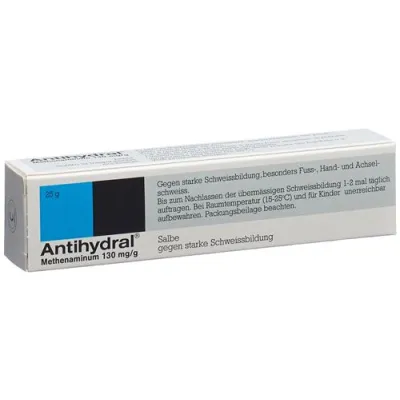Antihydral ointment
(1 Pages)
Antihydral ointment tube 25 g
What is Antihydral and when is it used? Antihydral is an ointment that is applied to the skin in case of heavy sweating. Excessive sweating, which occurs particularly in the armpits, hands and feet, is reduced with Antihydral. In this way, skin diseases that are closely related to heavy sweating can also be combated. Unpleasant and annoying body odor with increased sweating is prevented.When should Antihydral not be used?The preparation must not be used if there is a known hypersensitivity to an ingredient in the preparation or to formaldehyde. Antihydral must not be applied to weeping or blistered areas of skin. When is caution required when using Antihydral? If irritation or severe reddening of the skin occurs after the use of Antihydral, you should refrain from further use. Inform your doctor, pharmacist or druggist or your doctor, pharmacist or druggist if you - have other diseases suffer- have allergies or- take other medicines (including those you bought yourself!) or use them externally.Can Antihydral be used during pregnancy or while breastfeeding?Systematic scientific studies on pregnant women have never been carried out. As a precaution, you should avoid taking medicines during pregnancy and breastfeeding or ask your doctor, pharmacist or druggist for advice. Antihydral should not be used on the breast while breastfeeding.How do you use Antihydral?Adults:Antihydral is applied thinly to the affected areas of skin 1 - 2 times a day. Antihydral should be used until excessive perspiration subsides. The application can then be carried out at longer intervals as required. Sweaty foot skin is usually dry after just a few days and is resistant to chafing and blistering. After a few weeks, natural desquamation will usually result in skin that is softer and more prone to sweating, requiring the same treatment. Armpit and hand perspiration, which are known to be more difficult to control, require the application of Antihydral 1-2 times a day for a long time. Here, too, recurrences make it necessary to repeat the treatment. To prevent soreness in body crevices, e.g. thigh and buttock crevices, and as a protective ointment for prosthesis wearers and to prevent bed sores (decubitus), Antihydral should be applied to the endangered areas as required. Observe the dosage specified in the package leaflet or prescribed by the doctor. If you think the medicine is too weak or too strong, talk to your doctor, pharmacist or druggist.The use and safety of Antihydral in children and adolescents has not yet been tested.What side effects can Antihydral have?The following side effects can occur when using Antihydral:Hypersensitivity to formaldehyde can develop. Skin rash or eczema may occur in people who are hypersensitive to formaldehyde. Then stop using it and please inform your doctor, pharmacist or druggist. If the skin becomes too dry and chapped during the course of treatment, a greasy ointment should be applied temporarily.If you notice any side effects that are not described here, you should inform your doctor, pharmacist or druggist.What else should be observed?Medicines should be kept out of the reach of children. The medicinal product may only be used up to the date marked “EXP” on the containerin. Always close the tube tightly after use to prevent it from drying out. Store at room temperature (15 - 25°C). Your doctor, pharmacist or druggist can provide you with further information. These people have the detailed technical information.What does Antihydral contain?Methenamine 130 mg, white clay, zinc oxide 150 mg, glycerol, flavorings, colourings: E 172 (iron oxide) and other additives per 1 g of ointment.Authorization number33848 (Swissmedic)Wo do you get anti-hydral? What packs are available?In pharmacies and drugstores, without a doctor's prescription. Packs of 25 g.Authorization holderIromedica AG, 9014 St. GallenThis leaflet was last checked by the drug authority (Swissmedic) in November 2017...
47.88 USD
(1 Pages)

